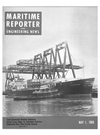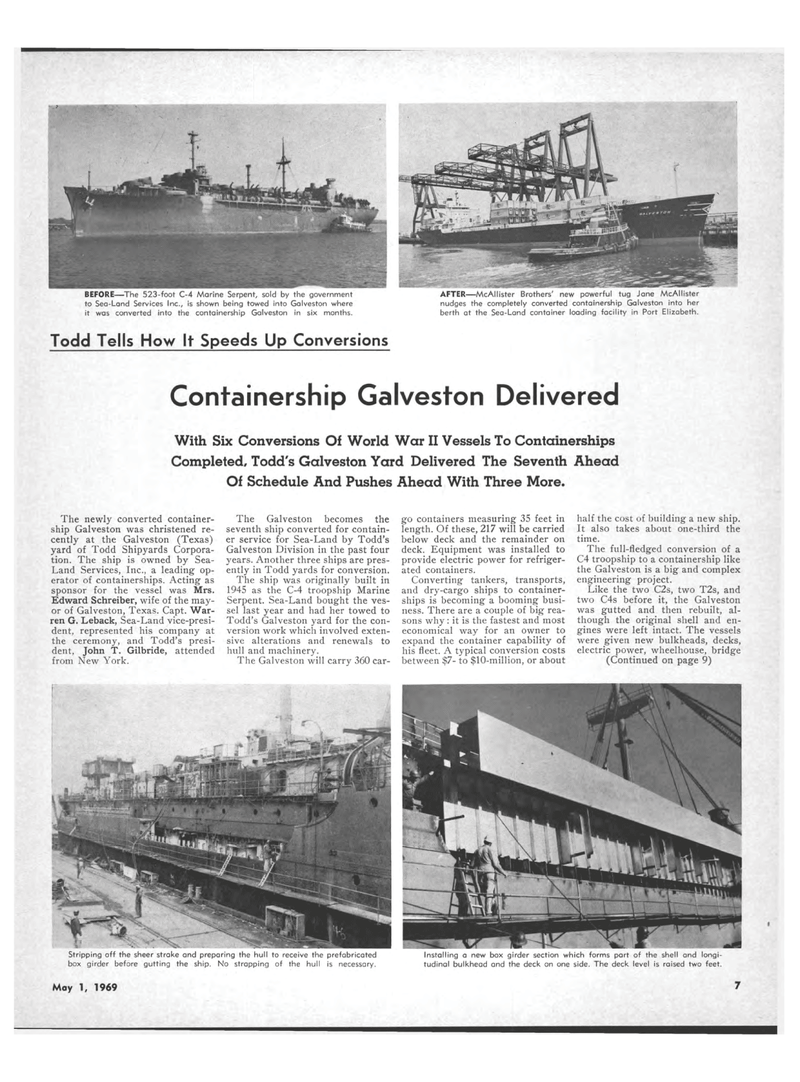
Page 5: of Maritime Reporter Magazine (May 1969)
Read this page in Pdf, Flash or Html5 edition of May 1969 Maritime Reporter Magazine
Containership Galveston Delivered BEFORE?The 523-foot C-4 Marine Serpent, sold by the government to Sea-Land Services Inc., is shown being towed into Galveston where it was converted into the containership Galveston in six months. Todd Tells How It Speeds Up Conversions With Six Conversions Of World War II Vessels To Containerships Completed, Todd's Galveston Yard Delivered The Seventh Ahead Of Schedule And Pushes Ahead With Three More. The newly converted container-ship Galveston was christened re-cently at the Galveston (Texas) yard of Todd Shipyards Corpora-tion. The ship is owned by Sea-Land Services, Inc., a leading op-erator of containerships. Acting as sponsor for the vessel was Mrs. Edward Schreiber, wife of the may-or of Galveston, Texas. Capt. War-ren G. Leback, Sea-Land vice-presi-dent, represented his company at the ceremony, and Todd's presi-dent, John T. Gilbride, attended from New York. The Galveston becomes the seventh ship converted for contain-er service for Sea-Land by Todd's Galveston Division in the past four years. Another three ships are pres-ently in Todd yards for conversion. The ship was originally built in 1945 as the C-4 troopship Marine Serpent. Sea-Land bought the ves-sel last year and had her towed to Todd's Galveston yard for the con-version work which involved exten-sive alterations and renewals to hull and machinery. The Galveston will carry 360 car-go containers measuring 35 feet in length. Of these, 217 will be carried below deck and the remainder on deck. Equipment was installed to provide electric power for refriger-ated containers. Converting tankers, transports, and dry-cargo ships to container-ships is becoming a booming busi-ness. There are a couple of big rea-sons why: it is the fastest and most economical way for an owner to expand the container capability of his fleet. A typical conversion costs between $7- to $10-million, or about half the cost of building a new ship. It also takes about one-third the time. The full-fledged conversion of a C4 troopship to a containership like the Galveston is a big and complex engineering project. Like the two C2s, two T2s, and two C4s before it, the Galveston was gutted and then rebuilt, al-though the original shell and en-gines were left intact. The vessels were given new bulkheads, decks, electric power, wheelhouse, bridge (Continued on page 9) AFTER?McAllister Brothers' new powerful tug Jane McAllister nudges the completely converted containership Galveston into her berth at the Sea-Land container loading facility in Port Elizabeth. Stripping off the sheer stroke and preparing the hull to receive the prefabricated Installing a new box girder section which forms part of the shell and longi-box girder before gutting the ship. No strapping of the hull is necessary. tudinal bulkhead and the deck on one side. The deck level is raised two feet. May 1, 1969 7

 4
4

 6
6
